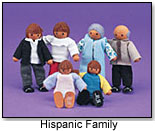
April 2, 2025


Click on the following link to read Part I of this TDmonthly report.
TDmonthly Magazine is preparing a report for specialty toy retailers. The TDmonthly report will help the retailers by covering specific ways to turn Wal-Mart´s and other discount mass merchandisers´ weakest points into opportunities. Below is a preview of some of the topics the report will touch on in greater detail.
Article Synopsis
|
Many retail experts agree that in order to compete with discounters such as Wal-Mart and Target, retailers must target a specific segment of the population. This strategy depends on carefully analyzing existing and potential customers and segmenting them into natural groups. Merchandise is then selected to attract members of a target group.
Rich Niches
The Girls’ Tween Market
A retailer’s customer base is often divisible by gender and age. Most experts consider it wiser to focus on girls than on boys, since boys tend to abandon toys in favor of video games around age 9, according to a 2004 NPD Group study. The “tween market” of girls aged 8 to 13 is a target group for stores in many locations, from big city American Girl stores to small town shops such as Snitty Snoots in Clarkesville, Ga.
Becky Sandven, owner of Snitty Snoots, targets the tween market because, she says, “teenagers just want to go to the mall.” She adds that teenage fashion trends change so quickly that she doesn’t dare try to carry teen clothes or accessories.
Sandven’s store succeeds in a rural area, with a Wal-Mart a few miles away, by specializing in Groovy Girls from Manhattan Toy Co. (ToyDirectoy) and similar toys and accessories for 8- to 13-year-old girls.
The owner was inspired to orient her store toward girls by concern for the problems she saw her eight granddaughters encounter. She decided to make her shop a source of “girl empowerment.” Asked how Snitty Snoots competes with Wal-Mart, Sandven says, “I just don´t do it! I watch to be sure I don´t carry the same things they have. And I make everything here special: unique accessories, special wrappings. I want every girl who comes in to end up feeling like a special person.”
Julie Wells, co-owner of Imagination Station in Franklin, Ind., limits the degree to which her store separates toys by gender. She does separate out dollhouses in one area and spy equipment and toolboxes in another. But many parents and grandparents don’t appreciate even this much division by gender. The Johnson County Daily Journal in Indiana quotes Purdue University professor Richard Feinberg as saying that parents are about evenly divided on this choice.
The only way to be sure about how a local market will respond to gender and toy issues is to survey customers and potential customers. Before starting Snitty Snoots two and a half years ago, Sandven did considerable market research. Internet research showed her that a distinct “tween” market was indeed emerging. Then she drove to visit a few model stores. Now new stores are beginning to copy hers.
The Infant Market
The infant market is another prime niche. According to the Toy Industry Association, one of the best merchandise niches is the infant video market, which has been trending up the last four years.
The Ethnic Market
If a retailer’s location permits, an ethnic market can offer a profitable merchandise niche. According to a 2004 report from the University of Georgia’s Selig Center for Economic Growth, the Hispanic, Asian, African American and Native American markets are growing much faster than the Caucasian market.
Hispanic buying power is growing the fastest, while the Asian market has the highest average income. Other industries are beginning to take advantage of the fast-growing Hispanic market. The Selig Center report offers ample information on each ethnic group’s preferences and characteristic spending patterns, along with a state-by-state analysis of buying power.
 Online retailer eLearningToys.com stocks a Hispanic Dollhouse set from Family Affair, which includes six 4” tall family members, Pretend and Play Hispanic Food, and a Family Affair set that includes Asian, Hispanic, Caucasian and African-American dolls.
Online retailer eLearningToys.com stocks a Hispanic Dollhouse set from Family Affair, which includes six 4” tall family members, Pretend and Play Hispanic Food, and a Family Affair set that includes Asian, Hispanic, Caucasian and African-American dolls.
However, the Selig Center report asserts that Hispanic shoppers prefer to shop in brick and mortar stores rather than online, so regular toy stores will have an advantage in this market.
A Simmons Hispanic Study in 2000 found that 67.2 percent of Hispanic adults had bought games and toys within the previous 12 months, while only 50.4 percent of the non-Hispanic population had purchased toys. Fisher-Price and Leapfrog have attempted to woo this lush demographic, with the latter company having developed several bilingual products, including its LeapPad books, singing plush toys, talking Explorer Globe and ABC Karaoke Machine.
Still, Raul Lopez, president of the market research firm The Cultural Access Group, says the toy industry has been slow to take advantage of the fact that 20 percent of all babies born in the United States are Hispanic.
Conclusion
Of course, in order to ascertain the demographics of a region or area, a retailer must perform market research. A breakdown of a demographic, either by income or age, can be found in census data files at government agencies. For a fee, computer marketing firms can generate a detailed, tailored report.
Knowing one’s customer and, what’s more, understanding which segment is buying at a particular moment, is crucial to retail success. After selecting a merchandise mix, retailers must know for whom this merchandise is meant.
Click on the following link to read Part III of this TDmonthly report.
Copyright © 2025 TDmonthly®, a division of TOYDIRECTORY.com®,
Inc.